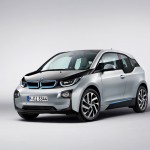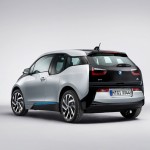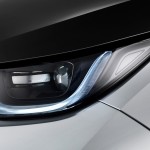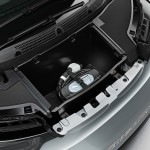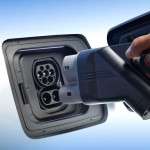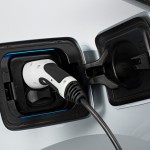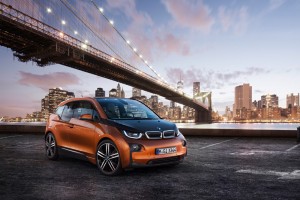
On Monday 29 July 2013, the ceremonial unveiling of the BMW i3 occurred in London, New York and Beijing. BMW claim it is, “the first premium car to be purpose-designed as an all-electric vehicle”. This is quite a wild claim considering offerings from the likes of Tesla and their Model S but we’ll ignore that fact for the moment as aside from both being electric drive, the two cars are quite different from one another.
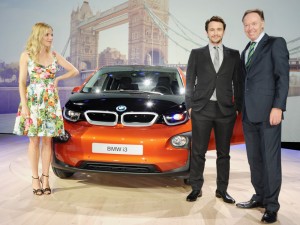
The highlight of the London event came after the formal unveiling of the BMW i3 when BMW Group hosted a launch party at Old Billingsgate Market. Some 600 people attended including star guests Sienna Miller and James Franco to celebrate the debut of the BMW i3. The actors were clearly impressed by the vehicle’s electric drive system and its consistent approach to sustainabitility in its design, as Sienna Miller said,
“Being a new mother I am very passionate about making green changes in my life to leave a better world for the next generation. 100% electric as well as stylish is something brand new which no one else offers making the BMW i3 the perfect city car for me”
James Franco appeared equally taken with the BMW i3 adding,
“As a champion of art and design I love the way BMW has managed to combine style, functionality and technology. This car makes being green cool, which is really important.”
Backing up the claims are BMW’s fresh approach to the manufacture of the i3. From the outset, BMW wanted to create a ‘sustainable car”, one which uses renewable energy to build and one which doesn’t emit harmful greenhouse gases. The i3 was “born electric”; it was designed from the ground up to be electric.
As often happens due to many reasons, manufacturers tend to borrow a platform chassis from another model to use as a base for the new car. As an example, the BMW 6 series is based on the 5 series platform. It is common and sensible practice; why reinvent the wheel? However, there are times when this is not possible or beneficial. In the traditional way, re-utilised platforms are great if you’re wanting to create a similar car with a different body style. BMW wanted to do something different with the i3 and as such starting from the ground up was a sensible option for an all electric car to be built.
Starting with the passenger cell, BMW has designed it to be mass produced in carbon fibre. Although there are many cars built using carbon fibre, for example it is used in a plethora of sports and super cars for saving weight and giving strength over steel or aluminium built cars, though it is usually to replace otherwise metal components such as a bonnet. A noteworthy exception which uses a carbon fibre chassis is the Mclaren MP4-12c – and of course almost every racing car on the track today uses carbon fibre extensively.
However, all the cars mentioned above are exotic, limited production run cars. They are not mass-market ‘average’ cars with price labels of less than £30,000. The BMW i3, on the other hand, is exactly that. With a starting price of £29,950 (inc. VAT) you’d be forgiven for not expecting to find a carbon fibre passenger cell. Not only that, BMW claims the carbon fibre is being produced using hydro electricity – which is significant as carbon fibre takes an enormous amount of energy and heat to cure properly in what are essentially large ovens.
BMW’s claims for the i3 breaking conventional mass-market production is beginning to shape up as true.
The passenger cell is put on an aluminium chassis which is also a lightweight material ideal for supporting the suspension and battery pack in the base of the vehicle. Aside from the rigidity and weight saving of the carbon fibre cell, BMW say it also gives a compact exterior to the car but not at the expense of a large interior.
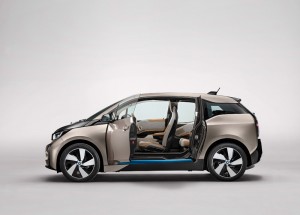
BMW’s purpose built approach meant the batteries (the heaviest component of the car) could be put where they should be, in the base of the vehicle, thus lowering the centre of gravity which will have a hugely beneficial effect on the handling of the car.
Moving onto the drive train, BMW are proud to tell you the i3’s drive is all BMW, developed in house rather than going to the international parts bin and grabbing an available electric motor. Although this is an honourable approach, it doesn’t necessarily mean it’s the best option. The BMW i3 has a range of approximately 90 miles in standard trim, which is comparable to cars such as the Nissan Leaf. However, with all the weight saving they’ve taken great effort to include (or should that be exclude) from the vehicle, a range as low as that is somewhat surprising.
The efficiency of the electric motor depends on many variables. In general there is a compromise any electric car manufacturer has to decide upon. Higher performance, i.e. faster acceleration tends to equal lower range. Lower performance tends to mean better range. The compromise between these two is a crucial choice and one which BMW had decided to give the i3 something roughly in-between the two.
No slouch, the BMW i3 gives acceleration figures of 0-62mph (0-100km/h) in approximately 7 seconds – brisk for a fiesta sized hatchback. It appears then that the i3 might have had a longer range, but at the expense of acceleration which is a good idea as I’ll explain.
BMW did extensive research into the average range required by most commuters and found the result to be that most, or 99% did less than 80 miles in a day. So, they set their target range for the i3 at just below 100 miles. Of course, in an ideal world, we’re sure that given the means BMW would have liked to have given the i3 a longer range on one charge, but with the current status of technology for electric motors and batteries, what they have given is – in all reality – ample for the average journey. Giving great performance is part of being a BMW so the car’s handling and acceleration were important for it to still feel like a true BMW, despite it being all electric. The acceleration figures are therefore important so the car feels agile and fast, even if those aren’t used by the driver when sat in traffic.
Take a look at the mobile phone in your pocket, ask BMW and realise that landline phones existed for over a century before the advent of mobile phones. BMW say the electric car is going to revolutionise the auto industry just as the mobile phone did to telecommunications. Although that was said in a marketing ‘make-it-visual’ sense, it does conveniently forget the fact that the electric motor has been around longer than the internal-combustion engine.
However, the electric motor has always been more efficient, instead it was the ‘fuel’ or batteries, that were the problem and to a large extent this is still true today. Even BMW admit this by making available an i3 with range extension option, the extra range of which is provided by a small capacity BMW motorbike derived twin cylinder petrol engine.
BMW’s claims of sustainability have been further enhanced in the production of the i3, claiming the actual factory where the i3’s will be built are using wind power for electricity supply. We’re pretty sure this wouldn’t be for the entire production and indeed in BMW’s own video showing the production facility, there is a single lonely wind turbine seen just outside it. However, it is a start in the right direction and a distinct possibility rather than a hair-brained scheme or dream. It’s a reality that renewable sources for energy are now feasible rather than laughable.
With the i3, what BMW have done is create a premium luxury small car, ideal for the vast majority of journeys and which should provide an engaging driving experience in total comfort and – they hope – without range anxiety. The question is, will consumers see the car as an expensive small car, or an innovative and inexpensive luxury electric car. This question does ring a familiar tune and BMW is not the first to try something like this. We refer you to the Audi A2 – a lightweight, all aluminium (small on the outside, large on the inside), frugal commuter car which gave exceptional fuel consumption for it’s day (and even by today’s standards isn’t bad) but was also much more expensive than the competing but much more conventional steel Mercedes A-Class which outsold it 10 to 1.
In conclusion, BMW have produced a futuristic and innovative vehicle, built using exotic super-car materials yet with a starting price less than £30,000. However, as with the Audi A2, is it a car ahead of it’s time or have BMW got the timing just right? There is a lot of interest in electric and hybrid cars on a worldwide scale and so there’s every reason to believe BMW have got it right. Whether or not the car is itself a good car in it’s own right; sustainability in production does not make for a good car by itself; remains to be seen and will become apparent in due course. We think the car looks great… or rather very interesting and different, yet is still recognisable as a BMW. Our hope is it drives as it should, like a BMW, but we’re certain that the effort, mentality, design, function, materials and the like are all very much BMW. BMW’s reputation and brand identity span their existing production and go into the design of their new products, else it is not a BMW.
With the i3, it is hard to determine yet whether BMWs brand identity has gone into it as it is radically different from any other BMW on the road today. Certainly the foundations have been laid for a solid, well refined and exciting electric car and we feel BMW has the right approach. Sales figures will do most of the talking from now on and in the meanwhile we will be anticipating expectantly the forthcoming BMW i8 hybrid sportscar.
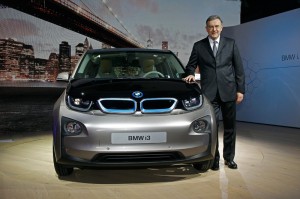
As a final closing statement, Dr. Norbert Reithofer, Chairman of the Board of Management of BMW AG speaking at the BMW i3 New York event said,
“The car has existed for nearly 130 years. Today marks a shift — a change — in the future of mobility. The BMW Group is proud to be driving this change. Today, the BMW i3 begins a new era: The era of true sustainable mobility.”
Photo source; BMW
